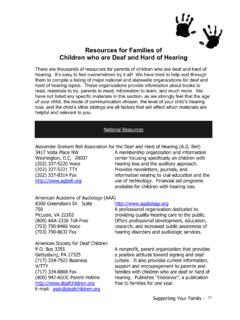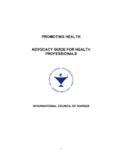Transcription of What is Advocacy - 121 Care
1 Queensland Advocacy Inc. What is Advocacy ? There are many definitions of Advocacy and much debate exists regarding which one is the most appropriate to use. Having a definition of Advocacy is necessary so that we have something to refer to, to check against and to encourage discussion about what we are doing. Action for Advocacy Development uses the following definition, which is based on the work of Dr Wolf Wolfensberger. Advocacy groups in Australia discussed this definition during a National Advocacy Workshop in Sydney in June 1994. Most of these elements were agreed to: Advocacy is speaking acting, writing with minimal conflict of interest on behalf of the sincerely perceived interests of a disadvantaged person or group to promote, protect and defend their welfare and justice by being on their side and no-one else s being primarily concerned with their fundamental needs remaining loyal and accountable to them in a way which is emphatic and vigorous and which is, or is likely to be, costly to the advocate or Advocacy group Page 1 Types of Advocacy A number of different types of Advocacy exist.
2 The strength of each Advocacy type depends on how well the individual, group or organisation s Advocacy efforts meet the key elements expressed in the definition of Advocacy . The types of Advocacy have been categorised in different ways. Here we will refer to five types of Advocacy : Individual Advocacy Citizen Advocacy Systems Advocacy Parent Advocacy Self Advocacy Sometimes only two types of Advocacy are talked about, individual and systems. Self Advocacy and citizen Advocacy are often regarded as individual Advocacy . Parent Advocacy is often regarded as either individual or systems. 1. Individual Advocacy Here the advocate concentrates their efforts on one or two people only. There are two common forms of individual Advocacy : a. Informal Advocacy Parents, brothers and sisters, relatives, friends who take on Advocacy roles are all examples of informal individual Advocacy .
3 Many different people, with a range of relationships to people with disability, have spoken out and persistently advocated for those who are vulnerable. What often goes unrecognised and unseen, are the efforts of individual people who may struggle with the injustices with little or no support. Such individual efforts have been termed informal Advocacy . These individual Advocacy efforts can and do last many years, often in significant isolation. Page 2 Page 3 These solo efforts can isolate individual advocates from their communities by the very nature of their efforts, particularly where the issue is controversial or perceived as detrimental to the wider system/environment in which the issue is placed.
4 For example, a parent s efforts to seek enrolment of a child with disability in a regular school in a local community may stir enmities, conflicting interests and test established friendships. These Advocacy efforts by individual people for valued lives need to be supported, nurtured and protected. Individual people may want to be connected to others doing Advocacy ; to share the effort, to seek support, or to develop a collective response. Individual advocates are encouraged to link with Advocacy groups for information resources and further contacts. b. Voluntary community based organisations Another form of individual Advocacy is voluntary community based organisations that pay staff to advocate for individuals. In Queensland organisations that operate in this way are Speaking Up for You (SUFY), Gold Coast Advocacy Group and Independent Advocacy in the Tropics (IAT).
5 2. Citizen Advocacy Citizen Advocacy is a community based movement that aims to recognise, promote and defend the rights, well being and interests of people with intellectual and/or multiple disabilities. It does so by finding and supporting caring, responsible citizens who make long-term voluntary commitment to make a positive difference in the life of a person who may be lonely, face difficult challenges, or be in at risk situations. Each Citizen Advocacy relationship is unique. The citizen advocate may for example, offer his or her prot g friendship, new experiences and opportunities, spokesmanship and protection from abuse. The Citizen Advocacy office carefully matches prot g s and citizen advocates to ensure there is a good match between the interests and needs of the prot g and the abilities, resources and commitment of the citizen advocate.
6 Citizen advocates are orientated, assisted to gain further knowledge and resources, supported and recruited by the Citizen Advocacy office. Organisations that operate using Citizen Advocacy are Capricorn Citizen Advocacy , South West Brisbane Citizen Advocacy and Sunshine Coast Citizen Advocacy . Page 4 3. Systems Advocacy This form of Advocacy is primarily concerned with influencing and changing the system (legislation, policy and practices) in ways that will benefit people with a disability as a group within society.
7 Systems advocates will encourage changes to the law, government and service policies and community attitudes. Usually systems Advocacy do not do individual Advocacy . To do so can cause conflict around the use of resources, focus and purpose. Organisations that operate on a systemic level are Queensland Advocacy Inc (QAI) and Queensland Parents for People with Disability (QPPD). 4. Parent Advocacy Parent Advocacy is concerned with advocating on issues that affect the person with a disability and their family. The focus is on the needs of the person with a disability, not the parents or family. However, some parent Advocacy focuses on the needs of parents first. Whilst parents have substantial needs for support and resources, when we talk about parent Advocacy we mean Advocacy by parent groups for people with a disability.
8 5. Self Advocacy Self Advocacy is undertaken by person or group who share the same characteristics or interests on behalf of the same person or group. The difficulty with this form of Advocacy is that sometimes those undertaking Advocacy and speaking up for themselves are likely to be further exposed and be more vulnerable to abuse, discrimination and ridicule as a result of speaking up for themselves. Page 5 Key elements of Advocacy There are a number of key elements of Advocacy .
9 To briefly explain the elements of Advocacy we have identified the following 6 as the predominant key elements. 1. Functioning by speaking out, acting or writing Advocacy is active. It involves doing something. It may be writing letters to politicians, raising issues of concern to organisations or services, being with a person when they are confronted with situations they find difficult, being with a person where they could be taken advantage of or fighting for a person s right to live a more fulfilling life. 2. Minimal conflict of interest This issue lies at the core of Advocacy and is one of the hardest, most important issues to come to grips with. In any situation there will be more than one person or groups interests that will be in conflict or competition with the interest of a person with a disability.
10 When you are in an Advocacy role, you need to be clear as to how your interest and needs may be in conflict with the person for whom you are advocating. As an advocate you must identify and attempt to reduce conflicts of interest or, at least, be prepared to acknowledge your limitations as an advocate. 3. Sincerely perceived interests This issue is one of the most complex and difficult issues for advocates to address. The advocate does not just speak up for what a person may want or what a person may be interested in. Advocates will be faced with making decisions about a person with disability s life and well being and may be the only individual in that person s life who has a positive vision for that person s future in the long term. When what a person says they want is different from what seems to be in their best interests, advocates are faced with a difficult dilemma.





